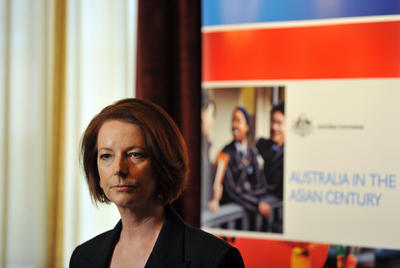Although the strategy of US President Barack Obama has received most attention, it is put to shame by the intelligence and depth of Australia’s approach.
The Australia in the Asian Century White Paper outlines the approach of Prime Minister Julia Gillard’s government. It is a strategy of vaulting ambition, with 25 ‘national objectives’ ranging across social, economic and foreign policy. Canberra is also willing to go where more capacious federations, such as Canada and Germany, are unable or unwilling to go — deep into the nation’s school curriculum — in order to produce an Asia-literate society.
Gillard’s strategy aims to give all Australian students access to at least one ‘priority’ Asian language — Mandarin, Hindi, Japanese or Bahasa Indonesia — throughout their years of schooling. It also aims to have one-third of all Australian senior civil servants and directors of leading public companies displaying ‘deep experience in and knowledge of Asia’ by 2025.
This approach could be labelled as ‘Asia or bust’. While Australia is not closer to many parts of the continent than, say, Canada (it takes about the same time to fly to New Delhi from Sydney than it does from Vancouver), its national psyche has become increasingly Asian. Kevin Rudd, a former Australian prime minister, recommended an Asian-languages strategy in 1994 when he served as a government adviser. Australia is putting the assets of national power — from education to intelligence, markets and diplomacy — behind its interests in the region.
By contrast, the pivots of both North America and Europe are half-hearted. This is because Asia continues to figure little in their ‘imaginaries’ — the values and cultural references that tie people together. Washington’s pivot is overwhelmingly military in emphasis. It includes enhanced rotation of US marines through Darwin, Australia, as well as the promise of an increased naval presence in the Pacific to the tune of 60 per cent of all US naval assets by 2020. Whether Beijing and, of course, Taipei, Tokyo, Seoul and Canberra see this reinforcement as credible, given US budgetary weakness, political bottlenecks and, just as importantly, America’s under-investment in Asian languages in its education system, is unclear.
Unlike Australia’s whole-country approach, America’s pivot asks little of its own people. No challenges are set. The same is true for Europe, a non-player in Asian geopolitics, for which the pivot is almost strictly and reductively economic in nature. The EU and Singapore have just signed an FTA (the EU–South Korea deal came into force in July 2011), and Brussels is actively laying the groundwork for similar deals with Japan and all of the ASEAN states. In November 2012, a summit in Laos between Asian and European leaders hardly registered in the European media and its outcomes were modest.
Moscow is, of course, working closely with Beijing on Syria and Iran at the UN and through the Shanghai Cooperation Organisation, an informal forum for Asian countries. Belarus, Georgia, Ukraine and Kazakhstan are studying countries such as Singapore for lessons in ‘governance’ — how to reconcile competent, quasi-authoritarian government with strong economic performance. Kiev’s positioning is intriguing: it is seeking a third way between a moralising Europe and an irredentist Russia.
What of Africa and Latin America? While China is deeply invested in the natural resource sectors on both continents, the truth is that most capitals in East Asia will quietly confess that they still don’t quite know how to strategically engage either continent. The reverse is also true. Embassies are being erected but diplomatic relationships are still in their early stages.
Beijing is assessing each pivot on its own merits, taking some more seriously than others, knowing full well that to understand China (and Asia more broadly), a country must mobilise more than just guns and money. It must change its culture. Australia has grasped this better than the rest of the world.
Irvin Studin is editor-in-chief of Global Brief magazine and a professor at the University of Toronto.
A version of this article was first published here in the Financial Times.


Very interesting article and I agree with most of the points. The Asian Century White Paper showed that Australia is on the right track. Leaning close to the US on the one, but seeking outreach to Asian countries on the other hand.
Barack Obama said that in Canberra “here, we see the future”. Could there have been any better statement by a US president to prove that the country is on the right way ahead. Universities are top class. Resource deals are already part of the foreign policy (India). The election in the Security Council worked out. Military modernization is underway. Thus, the right course has been set. Last but not least, the structure and the methodology of Asian Century White Paper’s “twenty-five national objectives for 2025” are well done – Short statements about the current environment; clearly defined aims; directly mentioned concrete means and ways for implementation. For someone used to read wordy, multilateralism-praising EU-papers, an enjoybale contrast.